Imitation Lobster Vs Imitation Crab: What's The Difference?
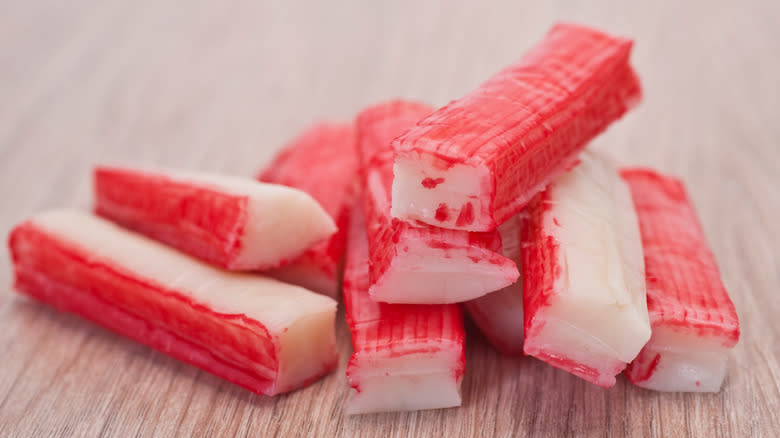
The word "imitation" often has a bad connotation, especially when it comes to food. No one wants an imposter on their plate, they want the real thing. Still, some foods are routinely accepted as stand-ins for the original. From truffle oil to the blueberries in your boxed muffin mix, not every food is entirely what it claims to be, which is what makes imitation seafood stand out from the rest.
Imitation crab is one of the more common and openly labeled replacement foods on the market. Its cousin, imitation lobster, is not seen quite as often but occupies the same space as a consumable that is clearly not authentic, but widely accepted. How did these shellfish get the seal of approval from consumers? And what differentiates them from each other? The answer begins in 12th-century Japan, and the links between these imposter shellfish are even closer than those between the creatures they emulate.
Read more: 6 Canned Meats You Should Buy And 6 You Shouldn't
What Is Imitation Crab?
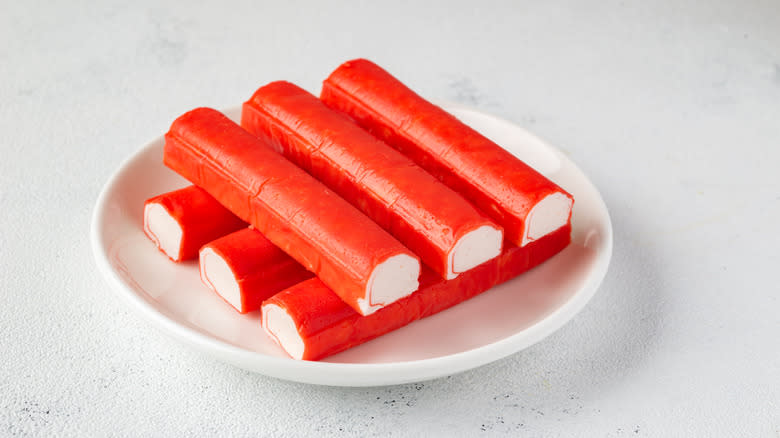
It's pretty easy to look at imitation crab and know it's not the real deal. The Spanish architect Antoni Gaudí famously said, "There are no straight lines in nature," and that's exactly how imitation crab is generally packaged -- in perfectly straight, uniform sticks. You can find products that package it chopped or flaked as well, but the sticks, reminiscent of a bright red cheese stick, are the most common.
That's because imitation crab is a processed combination of meats, starch, seasoning, and water. If any real crab is involved, which is rare, it comes in small quantities. That's not to say imitation crab is not seafood, though. The meat used is generally white fish, most commonly Alaskan pollock or Pacific whiting. Crab extract is used as the flavoring agent that gives these otherwise very mild fish the recognizable taste that crab lovers crave. It may not be real crab, but at least it usually tastes like it.
What Is Imitation Lobster?
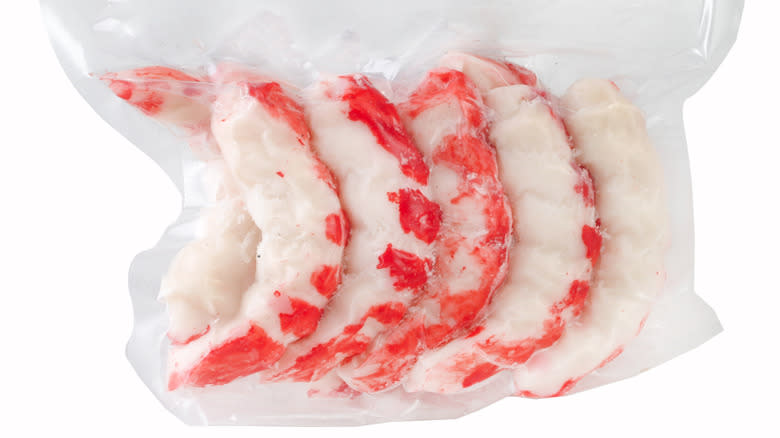
Much like its crustacean cousin, lobster meat is often imitated. Due to crab's popularity in sushi, imitation lobster tends to take a back seat to imitation crab even though they're made through the same process. Just like its counterpart, imitation lobster is a product of a fish-based combination. A look at five brands of imitation lobster shows that most contain 2% or less real lobster meat if any at all.
Whereas crab is generally formed into sticks, imitation lobster is shaped and colored to match the iconic tail meat that seafood fans recognize. The texture of imitation lobster is also often different from that of imitation crab, with the former being a bit meatier and more stable than the latter's somewhat flaky texture. Of course, the flavoring methods differ to help further distinguish the two. However, despite their differences, imitation crab and imitation lobster are closely related, largely because they're created from the same substance, the fish paste known as surimi.
What Is Surimi?
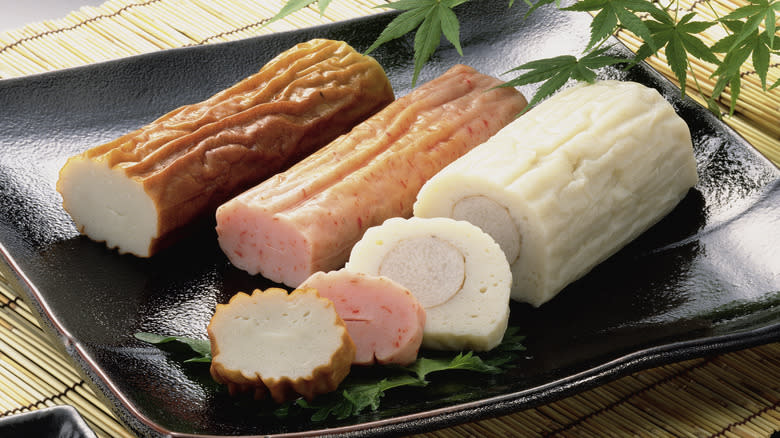
Surimi is a Japanese technique for preserving fish that dates back over 900 years. The process is fairly straightforward. First, the skin and bones are eliminated before the fish meat is finely chopped or pureed. To remove any additional fats or water-soluble items, the mixture is rinsed and then salted. From there, the resulting paste can be formed into a cake or loaf and cooked, usually steamed, or additional ingredients can be added to make the surimi freezer-stable.
Kamaboko is a Japanese surimi log that is often dyed to incorporate color both on the outside and inside and is commonly served with noodle dishes. (Think of the white and pink swirled pieces in a bowl of ramen.) Similar fish cakes are found in the Hawaiian dish saimin, which is a take on ramen. While imitation crab and lobster are variations of surimi, fish cakes are common in many Asian cuisines and can be prepared in several ways.
What Else Is In Surimi?
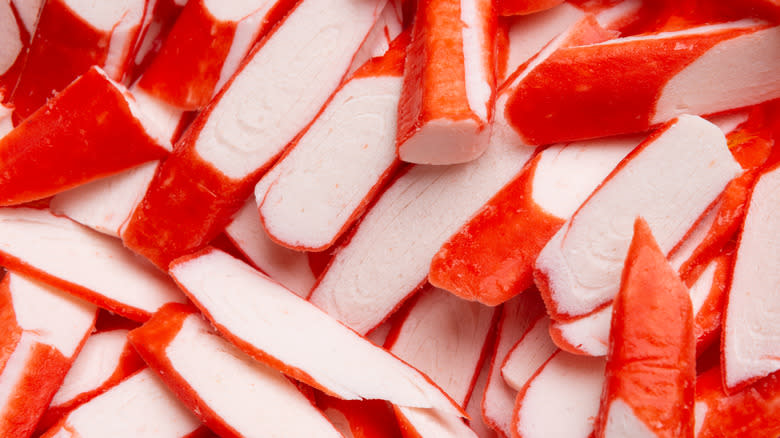
For most of its existence, surimi was a way of preserving fish before modern refrigeration, but there were still limits on how long the salted concoction would remain viable. It wasn't until the 1960s that a Japanese chemist experimented by adding sugar to the mixture, which allowed surimi to be frozen without denaturing the fish proteins, effectively preventing it from breaking down in the ice box.
For surimi such as imitation crab and lobster, binding agents are added to provide structure. Most imitation products include a starchy component like wheat, potato, corn starch, or pea starch, and a sugar product like sorbitol or standard white sugar. Eggs and vegetable oils are often added to improve the protein content and achieve the desired texture. There's also a lot of water. In fact, water is commonly the second most prevalent ingredient after fish in both imitation crab and lobster. Additionally, a range of dyes are used to give imitation crab its pink color.
Imitation Seafood Can Be More Sustainable Than The Real Stuff
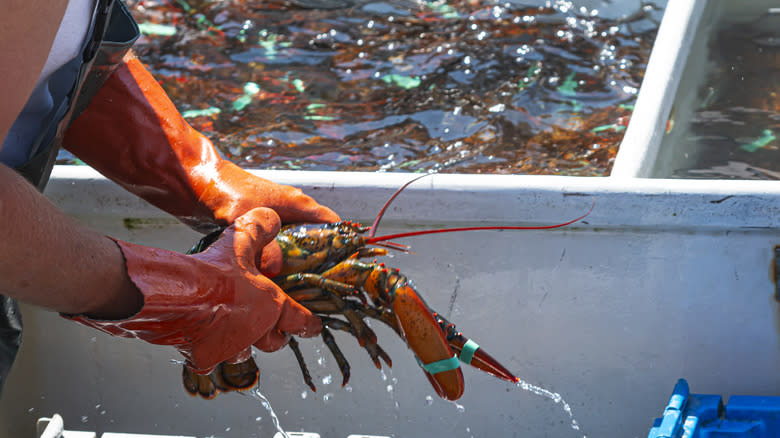
Sourcing issues and sustainability are major roadblocks to obtaining fresh crab and lobster. As the Earth grapples with the effects of global warming, the oceans are heating up fast, and spikes in temperature are having profound effects on the creatures that call it home. In 2022, the Alaska Department of Fish and Game shut down the Bering Sea's snow crab fisheries. The mass dieoff of an estimated 10 billion crabs was the culprit, representing a loss of 90% of the region's population. Things didn't get much better in 2023, forcing a second straight year of closures.
Lobster numbers are in a similar decline. Surveys performed by the Atlantic States Marine Fisheries Commission between 2018 and 2022 showed that the population of young lobsters had dropped by nearly 40% off the coast of New England compared to a two-year stretch between 2016 and 2018. While lobster fishing has been allowed to continue under major restrictions, the limited catch quantities combined with soaring prices have made imitation crab and lobster even more appealing, as conservationists work to restore decimated undersea populations.
Climate Change Presents Challenges For Imitation Pro
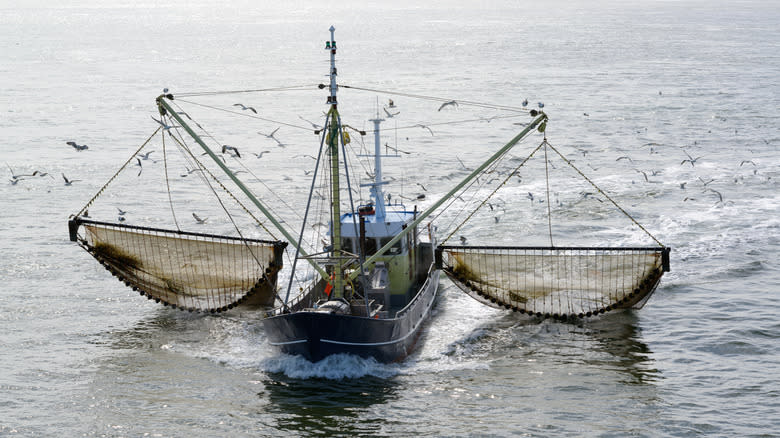
While imitation crab and lobster limit the stress put on native populations of crustaceans, climate change still presents challenges. A 2020 study conducted by the University of California, Santa Cruz, found that Alaskan pollock fishing -- the type of fish most commonly used in imitation crab and lobster as well as frozen fish sticks -- is fairly emission-efficient. Boats utilize midwater trawl nets to catch large quantities of fish at once, though warming oceans have made it more difficult to keep tabs on the pollock population. A series of surveys performed between 2017 and 2019 resulted in significantly different population estimates. New research suggests that warming ocean waters might be to blame as pollock populations spawn earlier and in new locations. Understanding the pollock population is important to ensure the fish can be harvested without overfishing.
Of course, while imitation products don't rely on crab or lobster, they do require large quantities of fish. While efficient, trawling nets catch everything in their path, whether it's pollock or other marine life. In Alaska, salmon are the most common bycatch, resulting in dwindling populations in the Yukon River, where they are a critical cog in the food supply for both animals and Native peoples.
Are Imitation Crab And Lobster Healthy?
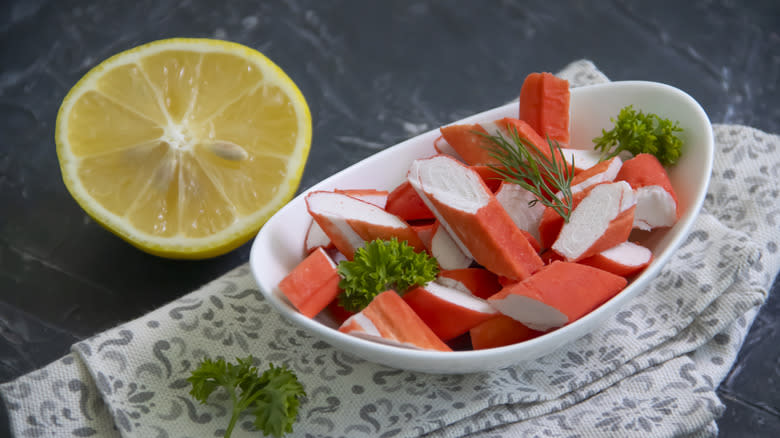
While there are positives and negatives related to the environmental impact of imitation crab and lobster, there's no denying that the authentic items are healthier. That's not to say the imitations are unhealthy, but they lack a fair bit of the nutrients that come from unprocessed meat. On the whole, surimi suffers nutritionally on two fronts. For one, a lot of nutrients are lost when the fish is processed and washed, while beneficial fats are sent down the drain along with waste products.
The most glaring difference, however, is in the protein content. Because surimi is a combination of fish meat with other fillers, equal quantities of imitation crab and lobster compared to the real deal contain about half the amount of protein. Added sugars also set imitation products back, though a serving only contains a few grams. In the end, they're not all bad for you, but the imitations can't offer the same nutrients as the authentic items.
What's The Cost Difference?
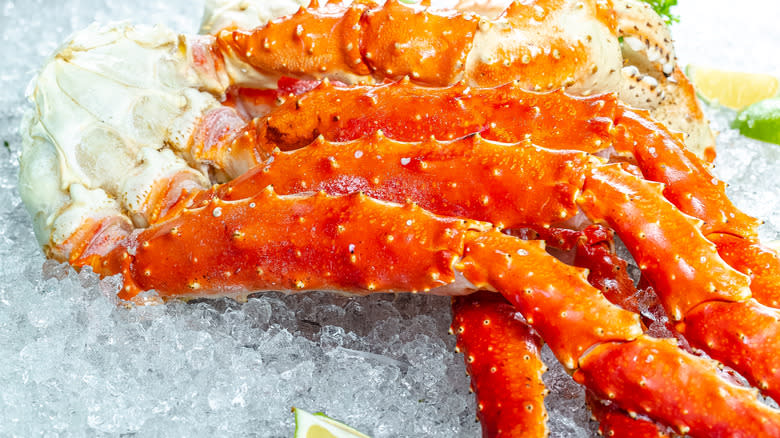
The major benefit of imitation crab and lobster is their cost. While nearly all fresh seafood is subject to wild price swings based on availability, the prices for imitation meats remain pretty consistent. As of mid-March, according to the Fisherman's Market Seafood Outlet in New Bedford, Massachusetts, the market price for 1 pound of snow crab or hardshell lobster was $19.99. Compare that to just over $6 for 1 pound of Kroger brand imitation crab and lobster, and it's easy to see why the processed versions are so popular both at home and in restaurants.
Most sushi restaurants use imitation crab in their rolls, and popular dishes like crab rangoon and crab salads do the same. Even well-known restaurants have been found to use imitation lobster in their dishes. A 2016 investigation showed that Red Lobster was using imitation lobster meat made out of langostino, a shellfish more closely related to a hermit crab, for its soup.
Can I Make My Own?
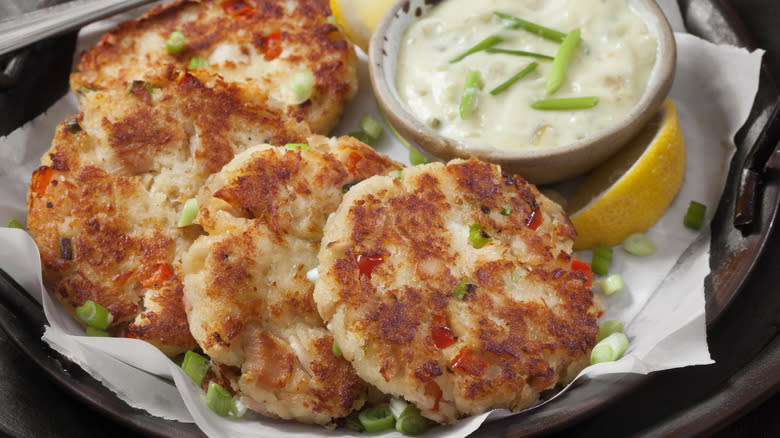
Much like trying to recreate any other highly processed food item, you can certainly do your best at home, but matching the exact texture and flavor of your favorite imitation crab or lobster can be tough. That said, it is possible to create a more standard surimi in the comfort of your own kitchen. There are plenty of recipes available online for both surimi and fish cakes.
Recipes call for ingredients such as white fish, salt, sugar, sake, egg white, and potato starch or corn flour as the binding agent. Everything goes into a food processor, and once the paste is ready, it can be formed into the desired shape and steamed or fried. Of course, it's probably easier and cheaper to buy surimi. While imitation crab and lobster are the most well-known varieties, surimi is also used in everything from fish sticks to frozen crab cakes.
How Do I Know If It's Imitation Or Real?
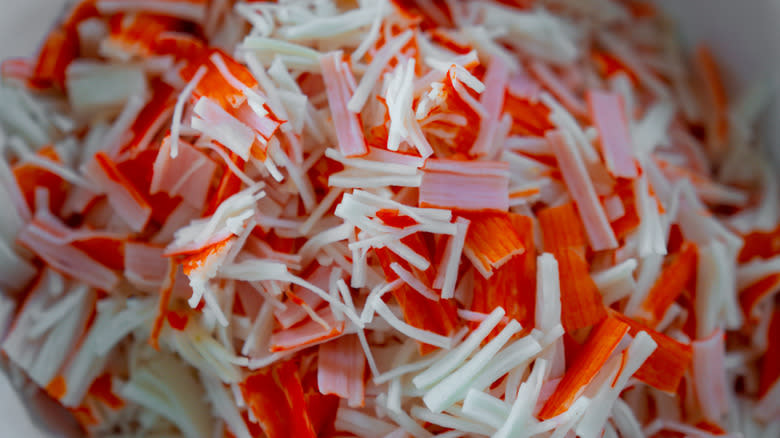
When you're the one making the purchase, it's pretty easy to tell if you're getting real or imitation crab or lobster. Even if there's not a claw in your grocery cart, the number at the checkout register should give you an answer. The FDA also mandates that any food products made with blended fish proteins, like surimi, must be labeled as imitation. So there's no need to worry that a package of flaked crab isn't the real thing unless it has the word "imitation" somewhere on the packaging.
Things get a little tougher when it comes to resale, though. There are no set rules as to how restaurants need to label their shellfish, which is why it's so common to find these processed products on menus. Some places will label their crab dishes as "krab" in order to differentiate authentic crab from imitation, but many places don't. A good barometer is the price and the quality of the food. While there's certainly nothing wrong with imitation crab, it's probably a safe bet that the free side of crab rangoon from your favorite Chinese takeout place isn't made with freshly caught Alaskan snow crab.
What Can I Make With Imitation Crab Or Lobster?
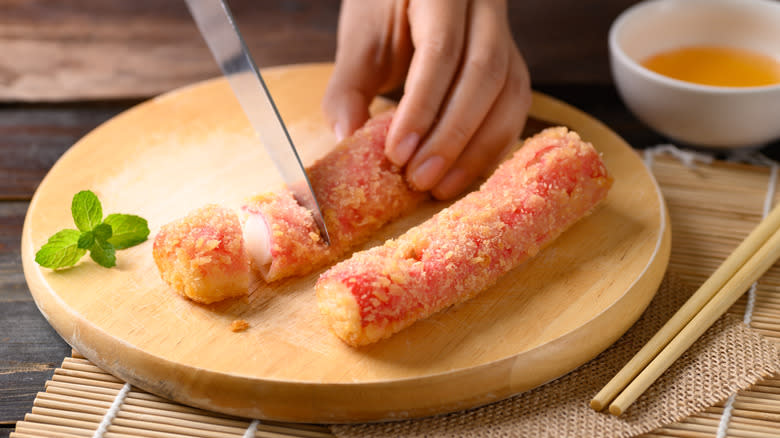
One of the major conveniences offered by imitation seafood is the fact that it's precooked. Whether you're making crab cakes, dip, or lobster bisque, there's no need to cook your imitation product in advance. As a result, there are plenty of dishes you can make with surimi, but there are some cooking tips to keep in mind. If you are heating imitation crab or lobster, be sure to do so in a way that won't affect the texture of the meat. Steaming or frying are tried and true methods, but try to avoid the microwave, or else your crab stick might come out rather rubbery.
It's also important to pick the right style of imitation meat for the dish you have in mind. Flaked products are good for dips and cakes, while sticks are perfect for sushi or a quick snack. As with any dish you're preparing for others, keep dietary restrictions in mind, since imitation crab and lobster contain possible allergens beyond their seafood base.
Read the original article on Mashed

